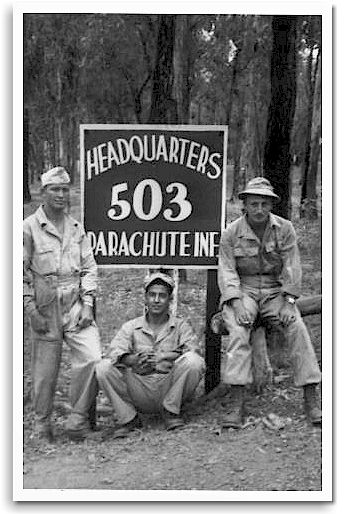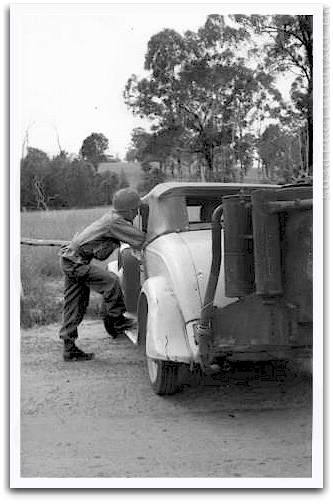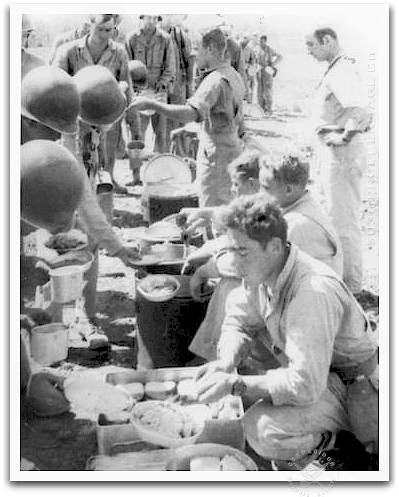|
-5-
From this position the Main Post Hospital stood out very prominently below me to
the north. It was to be one of Company "E"'s first objectives once it arrived
and had assembled. A little closer to the Barracks was the old Commissary
building. This stood on a bench which would be a good place for the Company to
set up its perimeter defense the first night on the Island. The elevated terrain
would provide a commanding view of the area in front of it.
Looking to the northeast, far enough away they were too small to identify, some
men were running across an open area on Morrison Hill.
All of a sudden there was the sound of rifles and a light machine gun opening
up. The men I had seen began to stumble and fall, laying still. At first I was
shocked we would be losing men so fast to enemy fire. Suddenly, it became
evident the men I was seeing were not ours but were Japanese troops running away
from third battalion men who were firing on them. There must have been ten or
twelve Japanese who had died for their emperor right before my eyes.
Near a part of the Barracks, which had been demolished by an explosion, I found
a location where we would set up our Command Post when the people in Company
Headquarters arrived. This was well to the west of the center of the building.
It would place us close, but not too close, to the Battalion and Regimental
Command Posts, which were both located in Mile Long Barracks.-
As the time approached 10:30 the sound of shelling could be heard in the
direction of Black Beach at Bottomside. There were too many buildings in the way
to be able to observe the landing but from the amount of small arms fire, in
addition to the shelling, it was evident the 3rd Battalion of the 34th Infantry
were landing according to the schedule.
The overall plan for the Rock Force was for the 34th Infantry to immediately
attack up the slope of Malinta
Hill,
secure the top and to move on beyond to cut the island so that Japanese
reinforcements from the east end of the island could not reach the west end.
This could be a difficult assignment for these men because Malinta Hill was a
steep, treacherous looking place. From the end of the Mile Long Barracks the
entrance to Malinta Tunnel could just be made out. There was a lot of fire being
poured into it. Shells were exploding nearly constantly.
Having no official duty which needed attention, I had a little time to look at
the buildings and the layout of Topside and reflect on how they must have looked
in the days when Fort Mills was one of the regular duty posts of the Army. The
buildings were badly pocked from bullets. Some of the buildings had been hit by
shells or bombs and had big parts missing or collapsed. Practically all roofs
had been blown off by concussion. Regardless, the place had a majesty about it
which held a person in awe. The Mile Long Barracks, in particular, was a wonder.
One felt it must have, certainly, been the largest single barracks building
anywhere. The whole building was three stories high. Although little remained
it was evident the first floor held the various headquarters for the 59th Coast
Artillery Batteries, along with the kitchens and mess halls, the showers,
storerooms, etc. The second and third floors, reached by concrete staircases,
had large squad rooms. It appeared the Non Commissioned Officers must have been
quartered elsewhere because there were no smaller rooms, such as the temporary
wooden barracks had at the end of each squad room.
Across the road from the Mile Long Barracks were the remains of a tram stop and
the ties of the rail system. The rails apparently had been taken up by the
Japanese invaders. There was a large building near the tram station which was
the movie theatre. It had a very substantial looking ticket window, much
different than the flimsy glass and light metal affairs of the theatres back in
the states. Somehow the rumor made the rounds the last movie to play at the
Topside theater was Gone With The Wind. I doubted this since I remembered having
seen the movie in 1940, well before the last film would have been shown on
Corregidor.
The last C-47 which had dropped the first wave had not left the area until 0940
for its return flight to Mindoro to pick up the second wave. Mindoro was 150
miles south, or a bit over an hour's flying time, point to point. Of course
there would, likely, be time in the pattern over the two airfields used by the
317th. To make the scheduled 1250 second drop would take some doing. Each plane
would have to be refueled, time could be spent rigging the artillery packs
Where they needed to be mounted.
There would be no need to worry about the Second Battalion being ready and
anxious to board when given the go-ahead by the Air Corps crews. They were at
Hill and Elmore strips waiting when the planes returned from dropping the first
wave. The heavily loaded men would take a bit of shoving and hauling, however ,
because they carried so much weight it was about
all they could do to waddle to the ladder leading to the door. Then
it was a case of men behind them on the ground giving a shove at the same the
men in the plane offered a hand and pulled them aboard. Each man, in his
eagerness to get under way, had forgotten how hot it would be in the plane as it
sat in the scorching hot tropical sun. The minute the men got in the plane the
sweat would pour from them and not just because of their nervousness. As soon as
the plane would get in the air and up to the eight or ten thousand feet altitude
they would fly at it would be so cold each man would be near freezing. There
seemed to be no happy medium.
The planes, after take-off formed into an echelon formation to make fighter
coverage more effective. The flights continued in that order until a few miles
south of Corregidor when they again formed into two, evenly spaced columns and
steered toward the two landing zones. The lift began to drop its troopers at
1250 and completed their mission at 1342.
During the time the first wave of jumpers had been on the ground, the wind had
picked up. As the time for the second jump approached the velocity had passed 25
knots in gusts. Since it looked as if it were going to get stronger as the day
went on, the people on the ground wished for the second wave to get there as
soon as possible.
Jumpmasters of the second wave had been instructed to count 10 seconds past
their Initial Points because of the increased wind velocity. Even with this
correction, a number of men were blown over the cliff, landing on the steep
slopes below the rim. Staff Sergeant Harry D. Clearwater was one who landed well
down the slope, breaking both legs. Staff Sergeant Robert V. Holt, Jr. landed
somewhat below Clearwater and somehow lost his weapon. Climbing toward the rim,
Holt found Clearwater and borrowed his Thompson Sub Machine Gun, promising to
send help. The help came, but not until 36 hours later.
The wind seemed to have shifted to a little more from the east than for the
first wave. Some of the aircraft did not compensate fully for this change and
flew a course too far to the west over the jump fields. As a consequence a
number of men were blown off the western edge of Landing Zone “A”, landing
around three large, two story buildings which housed senior Non Commissioned
Officers’ families prior to the war. Others landed near a large building which
been a radio station. Even from my vantage point two or three hundred yards
away, I could tell these buildings were effective anti-airborne hazards with
ragged concrete and exposed reinforcing-rods ready to impale or mangle a man.
Standing on the edge of Landing Zone “A”, next to the Mile Long Barracks and
watching what was happenig I knew what should have been done but, of course, was
powerless to do anything because I did not have contact with people in the
planes. If someone could have told them to fly about three hundred feet to the
east, these misses would not have happened. It is a very helpless feeling to
watch disasters happen and not be able to do anything to help.
While I watched, one man with almost a complete a streamer (his chute pulled
from his pack but not opened) crashed into the Mile Long Barracks with an impact
no man would be able to survive. But there were medical people in that area to
do what they could for him.
The first men hitting the silk seemed to be the sign for Japanese troops to
commence firing, particularly down in the Battery Wheeler area and in the upper
Cheney Ravine -area. Rifle and Machine Gun fire had been heavy east of Landing
Zone “B” ever since the first wave had landed and, particularly, since the 34th
Infantry had landed at Black Beach. Now that fire seemed closer and heavier than
ever.
I would be watching a man over the drop zone, with his chute full and doing its
job, swinging his arms and legs around trying to control his descent so as to
land where he wanted to. More than once I would see the man, suddenly, slump in
his harness as he had been hit by fire from the ground.
Several of the airplanes were struck by the light anti-aircraft fire from the
Japanese. I heard about that a bit later. It was not immediately evident while
watching from the ground.
When we landed with the first wave the Japanese were, mostly, in their shelters
to avoid our Air Corps bombing and strafing and were not out in the open ready
to shoot at us in the air. I was very lucky to be in the first wave. Because men
from the first wave were spread out over a large area of Topside, the Air Corps
fighters and bombers couldn't cover the second wave. By that time the Japanese
were ready for them and the jumpers were met with constant rifle and machine gun
fire.
Shortly, men from Company "E" began to work their way to where I was waiting for
them. First Lieutenants Joe M. Whitson, Jr., Roscoe Corder and Second
Lieutenants Lewis B. Crawford and Emery N. Ball arrived. I told them to head
down to the Western end of the Mile Long Barracks which was the Company’s
assembly point and try to keep the men spread out as they came in.
Having been on the island for around five hours I felt like a Corregidor veteran
as the Company began to arrive. Although it had been an exciting period, the
nervousness of the first few minutes, not knowing what to expect, had worn off
and I was as cool and collected as could be expected under the circumstances.
The 503rd had been in the tropics for a long time and the men had become as well
acclimated to the heat and humidity as anyone from temperate climates could
expect to be. Everyone had worked up a good sweat and pulled out their canteens
for a swig of water to freshen their mouths. On other operations we had gone in
with only one issue canteen. This time the planners had smartened up. Every man
was issued a second canteen and landed with each of them full. For some unknown
reason I had always been able to survive with less water than most. I had begun
using water out of my right hand canteen. Now I shook it and found it was at
least three quarters full. Some of the men coming in from the Landing Zone had
started on their second. I reminded them they had better slow up because we
didn't know when we would get any more. We had been warned that we could not
expect to find water on the island and that it could be as much as several days
before we could receive our first resupply. First priority for resupply during
the first day or so would be given to ammunition and weapons to replace those
which might have been lost or damaged.
I kept expecting First Lieutenant Hudson C. Hill, the Company Commander, but he
did not come in. I kept trying to raise him on the Walkie-talkie SCR 536 Company
network but to no avail. The SCR 536 had been notoriously fickle since they had
first been issued. They were of absolutely no use unless there was a perfect
line-of-sight between the two instruments. Apparently Hill was in a building or
behind a knoll where we could not see each other.
Finally, we made contact. Apparently Hill had moved so he was within range and
had a line-of-sight. He was asking me to get some artillery fire down in the
area of the NCO Quarters to take the pressure off him so he could get up to the
CP. Upon his insistence I went looking for an artillery officer but couldn't
find any. As near as I could tell the only completely assembled artillery piece,
at that time, was the one I had seen on the other side of the Mile Long
Barracks. There had been no officer with them. After quite a lot of scurrying
around looking for someone with authority in the Artillery, with no success, I
gave up. Shortly afterward Hill made his way to the CP very upset that he had
not received the artillery fire he wanted.
|







